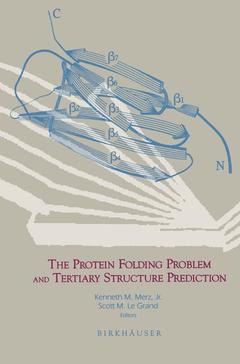The Protein Folding Problem and Tertiary Structure Prediction, Softcover reprint of the original 1st ed. 1994
Langue : Anglais
Coordonnateurs : Merz Kenneth M.Jr., LeGrand Scott M.

A solution to the protein folding problem has eluded researchers for more than 30 years. The stakes are high. Such a solution will make 40,000 more tertiary structures available for immediate study by translating the DNA sequence information in the sequence databases into three-dimensional protein structures. This translation will be indispensable for the analy sis of results from the Human Genome Project, de novo protein design, and many other areas of biotechnological research. Finally, an in-depth study of the rules of protein folding should provide vital clues to the protein fold ing process. The search for these rules is therefore an important objective for theoretical molecular biology. Both experimental and theoretical ap proaches have been used in the search for a solution, with many promising results but no general solution. In recent years, there has been an exponen tial increase in the power of computers. This has triggered an incredible outburst of theoretical approaches to solving the protein folding problem ranging from molecular dynamics-based studies of proteins in solution to the actual prediction of protein structures from first principles. This volume attempts to present a concise overview of these advances. Adrian Roitberg and Ron Elber describe the locally enhanced sam pling/simulated annealing conformational search algorithm (Chapter 1), which is potentially useful for the rapid conformational search of larger molecular systems.
1 Modeling Side Chains in Peptides and Proteins with the Locally Enhanced Sampling/Simulated Annealing Method.- 2 Conformation Searching Using Simulated Annealing.- 3 Multiple-Start Monte Carlo Docking of Flexible Ligands.- 4 The Genetic Algorithm and Protein Tertiary Structure Prediction.- 5 Conformational Search and Protein Folding.- 6 Building Protein Folds Using Distance Geometry: Towards a General Modeling and Prediction Method.- 7 Molecular Dynamics Studies of Protein and Peptide Folding and Unfolding.- 8 Contact Potential for Global Identification of Correct Protein Folding.- 9 Neural Networks for Molecular Sequence Classification.- 10 The “Dead-End Elimination” Theorem: A New Approach to the Side-Chain Packing Problem.- 11 Short Structural Motifs: Definition, Identification, and Applications.- 12 In Search of Protein Folds.- 13 An Adaptive Branch-and-Bound Minimization Method Based on Dynamic Programming.- 14 Computational Complexity, Protein Structure Prediction, and the Levinthal Paradox.- 15 Toward Quantitative Protein Structure Prediction.- 16 The Role of Interior Side-Chain Packing in Protein Folding and Stability.- Keyword Index.
Date de parution : 06-1994
Date de parution : 04-2012
Ouvrage de 581 p.
15.5x23.5 cm
Disponible chez l'éditeur (délai d'approvisionnement : 15 jours).
Prix indicatif 105,49 €
Ajouter au panierThème de The Protein Folding Problem and Tertiary Structure... :
© 2024 LAVOISIER S.A.S.



